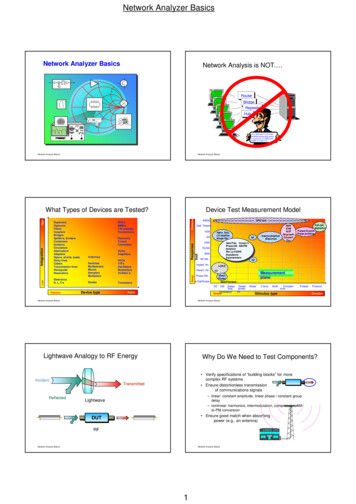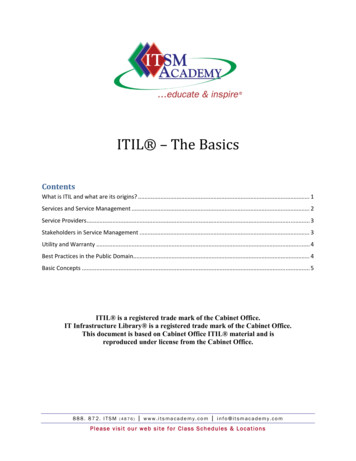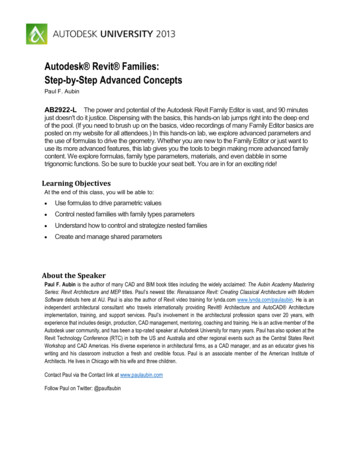
Transcription
UNC Chapel Hill School of Social Work Clinical InstituteUNC CHAPEL HILL SCHOOL OF SOCIAL WORKCLINICAL INSTITUTEAll parts are welcome:Using the internal family systemsmodel with individuals and partners,with(or without) trauma historyDeborah Klinger, LMFT, CEDS-SMarch 19, 202011IFS Basics Created by Richard Schwartz, Ph.D., LMFT. Combines systems thinking and family systemstheory with the notion of multiplicity of the mind–the human psyche is not monolithic but is madeup of many various parts and a Self. Everyone has an unknown number of parts. Parts are functional, and all parts are good. And everyone has a Self, the essential core of ourbeing that is by nature a compassionate presenceand has the capacity to be an active leader.22The External System33All Parts are Welcome w/ Deborah Klinger, LMFT, CEDS-S1
UNC Chapel Hill School of Social Work Clinical InstituteGeneral Systems Theory Systems theory is a conceptual frameworkbased on the principle that the componentparts of a system can best be understood inthe context of the relationships with eachother and with other systems, rather than inisolation.-Originated by Ludwig Von Bertalanffy44A System is a System is a System Systems theory tells us that all living things operateas part of one or more systems. Systems function according to certain principles,including that of maintaining homeostasis. If one thing in a system changes, it throws the wholesystem out of balance and the system tries the “rightthe ship” and return to the previous interactivedynamics, or it must find a new set of dynamics thatcreate a new homeostatic balance.55A System is a System is a System According to family systems theory (Bateson,Bowen, et al.), families are systems thatoperate according to these same principles. The way family members interact (e.g.,enmeshed or disengaged, with alliances,coalitions, and polarities) are governed bysystems principles. IFS says that an individual is a system, afamily of parts that operate the same way.66All Parts are Welcome w/ Deborah Klinger, LMFT, CEDS-S2
UNC Chapel Hill School of Social Work Clinical InstituteDo I contradict myself?Very well, then I contradict myself,(I am large, I contain multitudes.)-Walt Whitman in Song of Myself (1892)77The Internal System:Types of Parts In IFS therapy, the focus is on two primary types ofparts: protective parts and vulnerable parts. Vulnerable parts hold painful emotional statesand/or negative beliefs about themselves from pastwounding experiences. Protective parts’ job is to protect vulnerable partsfrom being activated, and to protect us from beingflooded by the pain that vulnerable parts hold.88Vulnerable Parts: Exiles99All Parts are Welcome w/ Deborah Klinger, LMFT, CEDS-S3
UNC Chapel Hill School of Social Work Clinical InstituteExiles When a wounding experience occurred in the past,the internal system “exiled” the wounded part, likelocking a metaphorical crying child in ametaphorical basement. The system “encysts” theExile. This enables us to continue to function, rather thanbeing overwhelmed or paralyzed by the paincontained in the vulnerable part. Their painful emotional states and negative beliefsabout themselves are referred to as “burdens.” Essential qualities that originally belonged to anExile get squeezed out by the weight of burdens.1010Exiles Exiles are younger, and of varying ages. An exile is the age of the person when the woundingcircumstance occurred. Exiles are stuck in the past. Their “present”experience is eternally the wounding circumstance. They become desperate in their attempts to be caredfor, banging on the metaphorical basement door. IFS enables us to bring Exiles out of the past and intothe present, where they can release their burdens andtake back their essential qualities. (Often, they’re notfar from our awareness– the “basement door” isn’tvery thick.)1111Protective Parts Protective parts assume roles that are moreextreme than their true natures, in responseto the circumstances that necessitate theexiling of parts. While their methods mayhave a harmful impact, their intentions arealways positive. There are two types of protective parts:Managers and Firefighters.1212All Parts are Welcome w/ Deborah Klinger, LMFT, CEDS-S4
UNC Chapel Hill School of Social Work Clinical InstituteProtective Parts Managers operate pre-emptively, lookingahead to the future and doing whatever theycan to keep exiled parts at bay. Firefighters operate reactively, jumping in tolock escapee exiles back down. They are onlyconcerned with the present, without regardfor consequences.Protective parts are often the age we were whenthey took on their roles.1313Managers1414Managers: Pre-emptive, Proactive, Future-oriented Managers are concerned with staying on top ofthings, keeping that basement door shut tight. They are focused on planning, controlling, andachieving, keeping things going. They can be goodorganizers or stern taskmasters, encouraging orcritical or people-pleasing. The more intense theaffect of the exiles, the more extreme the tactics ofthe Managers. Their extreme roles don’t match their true natures.1515All Parts are Welcome w/ Deborah Klinger, LMFT, CEDS-S5
UNC Chapel Hill School of Social Work Clinical InstituteFirefighters1616Firefighters: Reactive,Present-oriented Firefighters spring into action when life happens,and an Exile is triggered. They use impulsive, compulsive and/or addictivebehaviors, from nail-biting to heroin use todissociation, to distract, comfort, numb or check out. This puts the Exile “back in the basement.” Oncethat’s accomplished, the system is restored to itsdysfunctional homeostatic balance. Their extreme roles don’t match their true natures.1717A “Parts Triangle”ManagerFirefighterExileThanks to Cece Sykes for her Addictions TriangleThe dynamics of theinternal systemisomorphicallyreplicates dynamicsin an external familysystem1818All Parts are Welcome w/ Deborah Klinger, LMFT, CEDS-S6
UNC Chapel Hill School of Social Work Clinical InstitutePolarizationManagers and Firefighters often don’t get along.Managers can be critical of Firefighters’ behaviors: EXAMPLE: A Manager that tells a person whostruggles with overeating that she is disgusting andgross. The Manager’s intention is to stop theovereating, so the person will be more loveableand acceptable (via weight loss), but the overeaterpart (a Firefigher) believes that if she does, theperson will be flooded by pain (contained in Exileswho hold experiences of rejection).When two protective parts hold conflicting points ofview, they are polarized. This polarizationcontributes to maintaining the homeostatic balanceof the system.19192020Self The Self is the timeless, essential core of one’sbeing. Its qualities are known as the “8 21All Parts are Welcome w/ Deborah Klinger, LMFT, CEDS-S7
UNC Chapel Hill School of Social Work Clinical InstituteSelf “In IFS, when we speak of Self, we arereferring to a centered state of embodied selfawareness and self-acceptance, combinedwith a deep sense of how we connect toothers.”Sykes, C. C., (2016) "An IFS lens on addiction: compassion for extremeparts," in Sweezy, M. and Zizkind, E.L., Innovations and elaborations inInternal Family Systems, New York, NY, Routledge.2222Self We’re wired so that optimally, Self is the leaderof our internal systems, and our parts operate inharmony with Self and one another. (Self is“driving the bus.”) Everyone has a Self, but it can become coveredup by parts and lost awareness of/connectionto. We know we’re “in Self” or have “Self energy”present when we feel mostly one or more of the“C’s,” e.g., compassion or curiosity, toward anygiven part.2323Self Self has no agenda. Self-to-part relationship is key to healing. Self-like parts are Managers with positivequalities, but they can’t heal (“empathic ratherthan compassionate”). Like all Managers, Self-like parts want toprotect us from Exiles’ pain, so they’re likelyto want to comfort an Exile to get it to calmdown, rather than be with the Exile withcompassionate witnessing.2424All Parts are Welcome w/ Deborah Klinger, LMFT, CEDS-S8
UNC Chapel Hill School of Social Work Clinical InstituteThe Experience of PartsAwareness of parts occurs on a continuum.When we feel consumed by the affect of a givenpart, or see the world from its perspective, wesay we are “blended” with that part.We know that our ex-partner was nogood for us, but we are heartbroken, can’t stopcrying, and would go running back if theytexted. We’re aware of the “logical” part butblended with the heartbroken part. EXAMPLE:2525The Experience of Parts Further along at this end of the continuum, whenwe are overwhelmed by urges to behave a certainway, or by painful emotions, we are merged with orflooded by that part, and have little to noawareness of Self energy or other parts. Self andother parts are dissociated. Toward the other end, we are Self-led, aware ofand feeling the emotions and attitudes of partswith acceptance and compassion. (Pure Self istranscendence/Samadhi.)2626Self is Aware of and CanConnect to Parts CompassionatelyManagerFirefighterSELFExile2727All Parts are Welcome w/ Deborah Klinger, LMFT, CEDS-S9
UNC Chapel Hill School of Social Work Clinical InstituteIFS Therapy The goal of IFS therapy to bring the internal systeminto balance, with parts in the roles that are consistentwith their true natures, and Self as the leader. This is achieved by creating relationship between Selfand parts, and ”unburdening” Exiles (and sometimesburdened protectors). We begin with protective parts, usually, but not always,Managers.– Firefighters can be unstable or upsetting to a client’ssystem, and so Managers often jump in when thefocus is on a Firefighter.– Trying to access Exiles too soon will destabilize the28system.28IFS Therapy: Working WithProtectors “Insight” IFS work, in which the therapist guides theclient in getting to know a part, starts with what’scalled the “6 F’s:” The process begins by having the client direct theirattention inward and Find the part in or around theirbody. Parts usually manifest as a physical sensation,like tightness in the chest or butterflies in thestomach. Then the client is directed to Focus on this part, thenFlesh it out: see what else the client notices about it(shape, color, image, emotions, age range, etc.).2929IFS Therapy: Working With Protectors Therapist asks the client, “How do you Feel towardthis part?” This tells us whether/to what degree theclient is “in Self.” Anything other than neutral or one of the 8 “C’s”indicates that the client is blended with another part,which holds the feeling, e.g., fear or anger, toward (oran opinion of) the target part. The next “F” is beFriend, which can’t happen if theclient is blended with a part that feels negativelytoward the target part, and will only go so far if clientis blended with a Self-like part.3030All Parts are Welcome w/ Deborah Klinger, LMFT, CEDS-S10
UNC Chapel Hill School of Social Work Clinical InstituteIFS Therapy: Working With Protectors When a client is blended with another part, they aredirected to focus on that part, and to validate itspoint of view while explaining that at this time, theclient wants to get to know the target part. Thetherapist directs the client to ask the part that they’reblended with if it’s willing to move out of the way. Befriending parts is important. Protective partsmust be treated with respect and kindness, nomatter how aversive their strategies. During befriending, we employ the last “F,” askingabout the Fears of the part. Protectors always havefears of what would happen if they didn’t do theirjobs.3131IFS Therapy: Working With Protectors When a given part is seen, heard, acknowledged, andvalidated by Self, it often feels to that part like waterin the desert. But trust has to be built: sometimes several partsmust be befriended before the system is ready toallow connection to a target part. Sometimes it becomes clear in the course of the workthat the focus should shift to another part. Validating the awareness of positive intent helps giveparts the sense of safety they need in order to revealtheir protective functions.3232IFS Therapy: Working With Protectors Sometimes, parts won’t unblend. There can beseveral reasons for this, e.g., they’re afraid of whatwill happen if they do, they’re not aware of Self, theclient doesn’t have enough Self-energy available. When this is the case, the therapist can switch fromInsight work to Direct Access, in which the Self ofthe therapist talks directly to a blended part. Direct Access used to be employed only whenInsight work wasn’t working; more recently, it’sbecome a go-to for working with highly criticalmanagers (commonly known as “the Inner Critic”).3333All Parts are Welcome w/ Deborah Klinger, LMFT, CEDS-S11
UNC Chapel Hill School of Social Work Clinical InstituteIFS Therapy: Working With Protectors Usually, managers are burdened by and tired of theirjobs, and would prefer not to have to do what they’redoing, but they have taken on an extreme role out ofnecessity. During Insight work, when the target part feels safe,it usually wants to tell the client (the client’s Self)about itself. It’s invited to do so. Eventually, the therapist directs the client to ask thepart how it came to take on its current role originally;what the circumstances were that made it necessaryfor the part to assume its role. The part can use words or pictures, whatever its“language,” whatever works best for the client’sparts.3434IFS Therapy: Working With Exiles Often, this leads to a memory of one or more painfulevents, usually in childhood or adolescence. The younger version of themselves in the memory isan Exile. The client usually feels the emotions that they felt atthe time of the event, along with bodily sensationsgenerated by the nervous system, because they areblended to some degree with the exiled part.3535Working With Exiles:Befriending and Witnessing The therapist guides the client in connecting to andbefriending the Exile. When connection has been established, the client’sSelf is guided by the therapist to go into to past, intothe situation where the Exile is stuck. The client has dual awareness, with one foot in thepresent and one in the past. The Exile is given an opportunity to tell its story(“Witnessing”).3636All Parts are Welcome w/ Deborah Klinger, LMFT, CEDS-S12
UNC Chapel Hill School of Social Work Clinical InstituteWorking With Exiles:Retrieval and Unburdening When the Exile is ready, the client (in Self) canbring it out of the past and into the present. This isreferred to as “Retrieval.” The client’s Self, guided by the therapist, assists theExile in a ceremonial releasing of its burdens. Thisis known simply as “Unburdening.” Once the burdens are gone, the clients helps theyounger part in inviting back into its body anyessential qualities that had been displaced by theburdens. This process reunites the client withqualities that were originally theirs, moving themtoward wholeness.3737IFS Therapy:Integration and Completion The client is asked to check in with any protectiveparts that moved aside earlier on in the process, tosee it they have any questions, comments orconcerns, and to express appreciation to them. The therapist can encourage the client to spendtime with the retrieved part, via journaling orvisualization, between sessions. This can helporient the younger part to the present, and to makesure that it is, in fact still in the present (unnoticedburdens can cause a part to slip back the past).3838IFS Therapy:Integration and Completion The unburdening of and reintegration into thepresent system of Exiles enables protective parts tobecome spontaneously unburdened. This occurswhen a critical mass of given exiled parts has beenunburdened and has reabsorbed their essentialqualities. Unburdened protective parts revert to theiroriginal natures, and balance is restored to thesystem. The client is free of destructive behaviorsand is no longer tortured by the painful emotionalstates or negative beliefs about themselves andtheir bodies that had burdened their parts.3939All Parts are Welcome w/ Deborah Klinger, LMFT, CEDS-S13
UNC Chapel Hill School of Social Work Clinical InstituteSelf Leadership Ideally, Self becomes the leader of the client’sinternal system, and parts live in harmony with oneanother. Ideally, the therapist is doing their own internalwork, and is striving to be Self-led. “Self begets Self, and parts beget parts:” inrelationships, a person blended with a part will tendto activate a part in the other person, while a personwith a lot of Self energy present will tend to elicitmore Self-energy in the other person.A Self-led therapist will be better able to connect aclient to their Self, and to unblend from their parts.4040IFS for Addictions, EatingDisorders and TraumaFirefightersManagersBingeing, purging, overexercising, drinking, using,compulsive sex, gambling,anger, shopping,internet/phone use, videogames, porn, dysregulatedanger/rage We all have some FF’s (e.g.,craft beer, Facebook). They’renot all destructive, it’s amatter of degree.Restricting (food, etc.),controlling (intake, etc.),planning, rigidity,trying to be “good,”perfectionism, criticizing,judging, comparing,obsessive thinking,ruminating.Shame, guilt, fear, negative cognitions,pre-verbal ANS material, often fromattachment wounds. Trauma-basedbeliefs, emotions and sensations.ExilesThanks to Cece Sykes for her Addictions Triangle4141IFS for Addictions Addictions begin as Firefighter behaviors:substance use or process (e.g., gambling, sex). Attempts to moderate or control thesebehaviors are carried out by Mangers who arepolarized with these FF’s. Over time, as a person develops dependenceon and tolerance of the effects, Managers losetheir power.4242All Parts are Welcome w/ Deborah Klinger, LMFT, CEDS-S14
UNC Chapel Hill School of Social Work Clinical InstituteIFS for Addictions As the disorder progresses, Exiles holdingshame, guilt, fear, etc. are activated,triggering more “using” FF’s. Managers resort to hiding/ minimizing/defensiveness. The system can become overrun with FF’s,so Mangers who want to change areexternalized: held in the family/friends.4343IFS for Addictions IFS therapy: if the client is in treatment willingly,start with Managers who sought therapy/want help.If not, start w/Mangers who don’t want help/don’twant to stop. If the client is stopping the use and is clean/sober,Managers must ”work the program,” e.g., 12 Steps,DBT skills, etc. The more external support (residential or intensiveIOP, support groups) a person has in early recovery,the fewer external Exile triggers there are.4444IFS for Addictions Managers must work hard, skill up so clientcan tolerate exiles’ affect, otherwise client willreturn to using. As this happens, Exiles must be found andunburdened, otherwise they’ll be triggered(especially once out of a treatment setting) to apoint that Managers can no longer containthem and the using FF’s will step back in (thisis what causes relapse).4545All Parts are Welcome w/ Deborah Klinger, LMFT, CEDS-S15
UNC Chapel Hill School of Social Work Clinical InstituteIFS for Addictions Befriending dangerous FF’s is necessary, butonly possible when Managers are oriented toand in agreement with it. The more extreme the FF behavior (e.g., harddrugs, child pornography, other crime) thegreater the number of and/or more intenseand extreme the affect of the Exiles. Self energy toward all parts is key, in bothclient and therapist!4646IFS for Eating Disorders Some ED behaviors are proactive/preemptiveand thus managerial: restricting, dieting,”clean eating,” scheduled exercise. Some are reactive and thus FF-driven:bingeing, “emotional eating/compulsiveovereating,” purging (vomiting or laxatives),other “compensatory behaviors” (exercise,undereating).4747IFS for Eating Disorders ED Managers cite societally-endorsed, egosyntonic attitudes about managing weight,self-discipline, size-ism. Orthorexia and rigidexercise are common to anorexia and bulimia. The polarity between constricting Mangersand releasing FF’s is always present,regardless of the disorder. Restriction is a bigpart of BED. Awareness of therapist biases is important.4848All Parts are Welcome w/ Deborah Klinger, LMFT, CEDS-S16
UNC Chapel Hill School of Social Work Clinical InstituteIFS for Eating Disorders When Managers’ efforts to “be good” fail, aperson’s binger or overeater FF is triggeredeither because the underlying exiles can’t besuppressed or because of the physiologicaleffects of inadequate nutrition or both. Negative body image is often a managerialresponse (fear of fat alone and unloved) toExiles who hold shame/pain of having beenrejected: “Pin the Tail on the Donkey.”4949IFS for Eating Disorders A binger FF is “putting out the fire” of an Exile(s) thatthe restricting/dieting/clean eating Manager could nolonger contain. The person initially feels better. When the binge is over, exiles re-surface, oftencontaining shame and guilt. In BN or AN B/P subtype, a purger FF steps in, throwsup the binged food, pushing down the Exiles andcreating calm and quiet inside. Empty pure, safe. In BED, a Manager promises to do better startingtomorrow.5050IFS for Eating Disorders An undernourished brain makes thinkingobsessive and irrational. When treatinganorexia nervosa, adequate refeeding isnecessary in order to do effective IFS work.The brain must have enough nutrientscoming in to do the work of therapy. A challenge with AN is the lack of awarenessof the negative impact of managerial EDbehaviors and attitudes.5151All Parts are Welcome w/ Deborah Klinger, LMFT, CEDS-S17
UNC Chapel Hill School of Social Work Clinical InstituteIFS for Eating Disorders When clients can understand the negativeimpact of ED Managers’ behaviors, they canbefriend those parts and access the relatedExiles. When clients can appreciate the positiveintent of ego-dystonic FF behaviors, they canbefriend those parts and access the relatedExiles. As usual, a treatment team including an R.D.and M.D. is recommended.5252IFS for TraumaWhat is trauma?“Trauma is not the story of something thathappened back then. It’s the current imprint ofthat pain, horror, and fear living insidepeople.”“Trauma is a disease of not being present.”Van der Kolk, B. A. (2014). The body keeps the score: Brain,mind, and body in the healing of trauma. Viking.5353IFS for TraumaPolyvagal theory of the autonomic nervoussystem (ANS), created by Stephen Porges, PhD. Three Branches of the ANS:1. Parasympathetic Ventral Vagal branch:“Social Engagement System.”2. Sympathetic: “Fight or Flight,” and Freeze.3. Parasympathetic Dorsal Vagal branch:primitive– Collapse, Submit, Dissociate.5454All Parts are Welcome w/ Deborah Klinger, LMFT, CEDS-S18
UNC Chapel Hill School of Social Work Clinical InstituteRegulate Dysregulated Arousal andTrauma-Related AffectsAR(Ogden 2008)Hyperarousal: Fight, flight,freeze: panic, rage, terror, agitatedimmobilityOWindowof AffectToleranceUSALHypoarousal: Feigned death:despair, disgust, hopelessness,helplessness, shame, etc.Sensorimotor Psychotherapy Institute 20125555IFS for Trauma In reaction to a neuroceptively (notcognitively) perceived life threat, our animaldefenses mobilize: our SNS fight/flight isactivated so we can take action to defendourselves. Trauma occurs when there’s not time to reactor, if a perpetrator is more powerful than weare, or we’re dependent on them for survival(e.g., child-parent). Then the ANS shifts from SNS to PSNS/DV56and submit/collapse/dissociate.56IFS for Trauma Trauma is the experience of our mammaliandefenses, e.g., SNS, activated and beingunable to carry out the action the instigatedaction. The amygdala fires, emotions intensify, theprefrontal cortex goes offline, Broca’s area(language) shuts down. We’re overwhelmedand can’t integrate the experience. Exiles contain the un-integrated material.5757All Parts are Welcome w/ Deborah Klinger, LMFT, CEDS-S19
UNC Chapel Hill School of Social Work Clinical InstituteIFS for TraumaIs it trauma, an attachment wound, orattachment trauma?T A ATAttachment trauma: when the perpetrator is a parentor caregiver. Often the case with disorganizedattachment.5858IFS for Trauma Managers have come up with strategies for keepingtraumatized Exiles suppressed, in service of day-today functioning. Meet Mangers with Self and help calm their fearsbefore addressing those Exiles. Exiles contain the un-integrated material. IFS works well for attachment/ developmentaltrauma because of the conceptual framework of theinternal system. IFS treats generational and “inherited” trauma byaddressing “legacy burdens.”5959IFS for Trauma When meeting and witnessing a traumatized Exile,the body will often begin to move with the activationof thwarted defensive actions. Therapist’s and client’s Self presence enables theclient to remain “in their window.” Therapist’s understanding of ANS and fight/flightmovements is helpful. As always when working withExiles, therapist checks in with client to see if theirexperience is tolerable. If not, the Exile is asked to“turn down” the intensity.6060All Parts are Welcome w/ Deborah Klinger, LMFT, CEDS-S20
UNC Chapel Hill School of Social Work Clinical InstituteInterweaving IFS with OtherModalitiesEMDR: ”Memory channels” are sets of Exiles. EMDR can work when the protective systemis so airtight that there’s not enough access toSelf, and the therapist’s Self isn’t enough. EMDR “cuts through” protectors. Can be used when IFS work is stuck, and thenIFS can be resumed after a targeted event isresolved (Exile is healed).6161Interweaving IFS with OtherModalitiesSomatic Experiencing and SensorimotorPsychotherapy: When tracking ANS activation, think oftrauma-related feelings and movementimpulses as the language of an Exile andurges/behaviors to avoid or push away theaffect and sensation as protective parts. Resourcing, grounding, and/or orientingtechniques can set the stage for IFS work.6262Interweaving IFS with OtherModalitiesSensorimotor Psychotherapy: Character strategiesThe Child and the Adaptive Wounded“Adult-child reunion”When parts are accessed, therapist can shift toIFS to work with them.6363All Parts are Welcome w/ Deborah Klinger, LMFT, CEDS-S21
UNC Chapel Hill School of Social Work Clinical InstituteInterweaving IFS with OtherModalitiesDialectical Behavioral terweaving IFS with OtherModalities Dialectical Behavioral Therapy (DBT):– Maladaptive coping strategies (e.g., self-harm,compulsions, substance misuse, suicidalideation/behaviors) are conducted by Firefighters.– Dysregulated emotions/“Emotion Mind” that theM.C.S’s are attempting to suppress/avoid/controlare held in Exiles.– Reason Mind is (typically) held in Managers.– Body Mind is a combination of all types of parts.– Wise Mind is similar to Self, but different 6565Interweaving IFS with OtherModalities DBT:– Wise Mind comprises aspects of Emotion Mind,Reason Mind and Body Mind, but also an intuitiveknowing, while Self is what’s there when partsunblend.– Self practices mindfulness, with nonjudgmentalawareness. (If a person doesn’t have access toenough Self energy, a self-like part can do this.)– Managers learn and apply the skills.6666–sAll Parts are Welcome w/ Deborah Klinger, LMFT, CEDS-S22
UNC Chapel Hill School of Social Work Clinical InstituteInterweaving IFS with OtherModalitiesDBT: Chain Analyses:– Target Behaviors Firefighter attempts to distractfrom/push away/get rid of Exiles’ painful affect.– Vulnerabilities Exiles and situations in which Exilesare potentially triggered, that Managers can’t dealwith effectively.– Actions behaviors of protectors trying toavoid/distract from E’s affect.– Body Sensation ANS reactions:fight/flight/freeze/collapse.– Cognitions thoughts any type of part is having.6767IFS with CouplesManagerExileFirefighterPartner #1Partner #2FirefighterManagerExileExiles crave kind attention, but protectors are on thefront lines, interacting with and triggering one another.6868IFS with Couples1.Manager:Why are yougetting home solate? You didn’teven call or text!(critical)5.Firefighter:Withdraw, shutdown, watch TV, havea beer (or several)4. Exile:They’re right,I’m mean andbad. (shame)6. Exile:I’m unlovablePartner #17.Firefighter:Yell, slam doors (anger)Partner #23. Manager: You’resuch a & %! Always onmy case! (critical,defensive)2. Exile: Nomatter howhard I try, I’mnot goodenough. (guilt,inadequacy)8. SameExileSolution: “You-Turn.” Help each partner access Selfand connect to and help their own parts.6969All Parts are Welcome w/ Deborah Klinger, LMFT, CEDS-S23
UNC Chapel Hill School of Social Work Clinical InstituteIFS with CouplesManager: WhyExile: They’reright, I’m meanand bad.(shame)Firefighter:are you gettinghome so late? Youdidn’t even call ortext! (critical)Withdraw, shutdown, watch TV, havea beer (or several)Self ofPartner #1Self ofPartner #2Exile:I’m unlovableFirefighter:Yell, slam doors(anger)Exile: Nomatter howhard I try, I’mnot goodenough.(guilt,inadequacy)Manager: You’resuch a & %! Alwayson my case!(critical, defensive)Solution: Guide both partners in speaking for, not from theirparts, do IFS work with each partner while other witnesses.7070Therapist aretakerChecking outIrritatedUrges to”Figure it Out”(eat chocolate,Anxiety/inadequacy(“She’ll realize I don’tknow what I’mdoing”)Achievershop, check FB )Fear/shame/SNSactivation (in reactionto angry ordysregulated client)Examples from your own experience?7171Bookshelf7272All Parts are Welcome w/ Deborah Klinger, LMFT, CEDS-S24
UNC Chapel Hill School of Social Work Clinical I
A System is a System is a System Systems theory tells us that all living things operate as part of one or more systems. Systems function according to certain principles, including that of maintaining homeostasis. If one thing in a system changes, it throws the whole system out of










